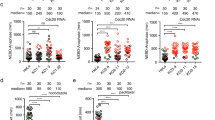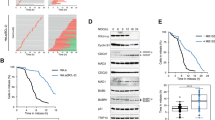Abstract
Activation of the protein kinases ATM and ATR following chromosomal breakage prevents initiation of DNA replication and entry into mitosis. However, the effects of ATM and ATR activation in cells already progressing through mitosis are poorly understood. Here we report that ATM and ATR activation induced by DNA double-strand breaks (DSBs) inhibits centrosome-driven spindle assembly in Xenopus laevis mitotic egg extract and somatic cells, delaying mitotic progression. Using a cDNA expression library to screen for ATM and ATR substrates, we identified centrosomal protein CEP63 as an ATM and ATR target required for normal spindle assembly. ATM and ATR phosphorylate Xenopus CEP63 (XCEP63) on Ser 560 and promote its delocalization from the centrosome. Suppression of ATM and ATR activity or mutation of XCEP63 Ser 560 to Ala prevented spindle assembly defects. Consistently, inactivation of the CEP63 gene in avian DT40 cells impaired spindle assembly and prevented ATM- and ATR-dependent effects on mitosis. These data indicate that ATM and ATR control mitotic events in vertebrate cells by targeting CEP63 and centrosome dependent spindle assembly.
This is a preview of subscription content, access via your institution
Access options
Subscribe to this journal
Receive 12 print issues and online access
$209.00 per year
only $17.42 per issue
Buy this article
- Purchase on Springer Link
- Instant access to full article PDF
Prices may be subject to local taxes which are calculated during checkout





Similar content being viewed by others
Accession codes
References
Maller, J. L. et al. The mechanism of CSF arrest in vertebrate oocytes. Mol. Cell Endocrinol. 187, 173–178 (2002).
Desai, A., Murray, A., Mitchison, T. J. & Walczak, C. E. The use of Xenopus egg extracts to study mitotic spindle assembly and function in vitro. Methods Cell Biol. 61, 385–412 (1999).
Costanzo, V., Paull, T., Gottesman, M. & Gautier, J. Mre11 assembles linear DNA fragments into DNA damage signaling complexes. PLoS Biol. 2, E110 (2004).
Yoo, H. Y., Shevchenko, A. & Dunphy, W. G. Mcm2 is a direct substrate of ATM and ATR during DNA damage and DNA replication checkpoint responses. J. Biol. Chem. 279, 53353–53364 (2004).
Hickson, I. et al. Identification and characterization of a novel and specific inhibitor of the ataxia-telangiectasia mutated kinase ATM. Cancer Res. 64, 9152–9159 (2004).
Jazayeri, A. et al. ATM- and cell cycle-dependent regulation of ATR in response to DNA double-strand breaks. Nature Cell Biol. 8, 37–45 (2006).
Potapova, T. A. et al. The reversibility of mitotic exit in vertebrate cells. Nature 440, 954–958 (2006).
Liu, J. & Maller, J. L. Xenopus Polo-like kinase Plx1: a multifunctional mitotic kinase. Oncogene 24, 238–247 (2005).
Sancar, A., Lindsey-Boltz, L. A., Unsal-Kacmaz, K. & Linn., S. Molecular mechanisms of mammalian DNA repair and the DNA damage checkpoints. Annu. Rev. Biochem. 73, 39–85 (2004).
Carazo-Salas, R. E. et al. Generation of GTP-bound Ran by RCC1 is required for chromatin-induced mitotic spindle formation. Nature 400, 178–181 (1999).
Heald, R. et al. Self-organization of microtubules into bipolar spindles around artificial chromosomes in Xenopus egg extracts. Nature 382, 420–425 (1996).
Karsenti, E. & Vernos, I. The mitotic spindle: a self-made machine. Science 294, 543–547 (2001).
Heald, R., Tournebize, R., Habermann, A., Karsenti, E. & Hyman, A. Spindle assembly in Xenopus egg extracts: respective roles of centrosomes and microtubule self-organization. J. Cell Biol. 138, 615–628 (1997).
Lustig, K. D. et al. Small pool expression screening: identification of genes involved in cell cycle control, apoptosis, and early development. Methods Enzymol. 283, 83–99 (1997).
Andersen, J. S. et al. Proteomic characterization of the human centrosome by protein correlation profiling. Nature 426, 570–574 (2003).
Zachos, G. et al. Chk1 is required for spindle checkpoint function. Dev. Cell 12, 247–260 (2007).
Matsumoto, Y. & Maller, J. L. Calcium, calmodulin and CaMKII requirement for initiation of centrosome duplication in Xenopus egg extracts. Science 295, 499–502 (2002).
Dodson, H. et al. Centrosome amplification induced by DNA damage occurs during a prolonged G2 phase and involves ATM. EMBO J. 23, 3864–3873 (2004).
Khodjakov, A., Cole, R. W., Oakley, B. R. & Rieder, C. L. Centrosome-independent mitotic spindle formation in vertebrates. Curr. Biol. 10, 59–67 (2000).
Zachos, G., Rainey, M. D. & Gillespie, D. A. Chk1-deficient tumour cells are viable but exhibit multiple checkpoint and survival defects. EMBO J. 22, 713–723 (2003).
Matsumoto, Y. & Maller, J. L. A centrosomal localization signal in cyclin E required for Cdk2-independent S. phase entry. Science 306, 885–888 (2004).
Vagnarelli, P. et al. Condensin and Repo-Man-PP1 cooperate in the regulation of chromosome architecture during mitosis. Nature Cell Biol. 8, 1133–1142 (2006).
Skoufias, D. A., Lacroix, F. B., Andreassen, P. R., Wilson, L. & Margolis, R. L. Inhibition of DNA decatenation, but not DNA damage, arrests cells at metaphase. Mol. Cell 15, 977–990 (2004).
Goodarzi, A. A. et al. ATM signaling facilitates repair of DNA double-strand breaks associated with heterochromatin. Mol. Cell 31, 167–177 (2008).
Morrison, C. & Rieder, C. L. Chromosome damage and progression into and through mitosis in vertebrates. DNA Repair 3, 1133–1139 (2004).
Basto, R. et al. Centrosome amplification can initiate tumorigenesis in flies. Cell 133, 1032–1042 (2008).
Griffith, E. et al. Mutations in pericentrin cause Seckel syndrome with defective ATR-dependent DNA damage signaling. Nature Genet. 40, 232–236 (2008).
Buim, M. E., Soares, F. A., Sarkis, A. S. & Nagai, M. A. The transcripts of SFRP1, CEP63 and EIF4G2 genes are frequently downregulated in transitional cell carcinomas of the bladder. Oncology 69, 445–454 (2005).
Morris, J. A., Kandpal, G., Ma, L. & Austin, C. P. DISC1 (disrupted-in-schizophrenia 1) is a centrosome-associated protein that interacts with MAP1A, MIPT3, ATF4/5 and NUDEL: regulation and loss of interaction with mutation. Hum. Mol. Genet. 12, 1591–1608 (2003).
Kamiya, A. et al. A schizophrenia-associated mutation of DISC1 perturbs cerebral cortex development. Nature Cell Biol. 7, 1167–1178 (2005).
Acknowledgements
We thank Tim Hunt, members of Clare Hall Laboratories and of the Genome Stability Unit for their comments. We thank H Mahbubani and J Kirk for technical support with Xenopus laevis. This work was funded by Cancer Research UK. V. Costanzo is also supported by the Lister Institute of Preventive Medicine, the European Research Council (ERC) start up grant and the EMBO Young Investigator Program (YIP). A. Vindigni thanks AIRC for its support.
Author information
Authors and Affiliations
Contributions
E.S, D.D. and A.B. performed the experiments and analysed the data in the Xenopus system and in avian DT40 cells; M.H., C.L. and A.V. provided technical and conceptual advice with mass spectrometry; S.T. provided technical and conceptual advice with avian DT40 cells; V.C. planned the experiments and wrote the manuscript.
Corresponding author
Ethics declarations
Competing interests
The authors declare no competing financial interests.
Supplementary information
Supplementary Information
Supplementary Information (PDF 1760 kb)
Rights and permissions
About this article
Cite this article
Smith, E., Dejsuphong, D., Balestrini, A. et al. An ATM- and ATR-dependent checkpoint inactivates spindle assembly by targeting CEP63. Nat Cell Biol 11, 278–285 (2009). https://doi.org/10.1038/ncb1835
Received:
Accepted:
Published:
Issue Date:
DOI: https://doi.org/10.1038/ncb1835
This article is cited by
-
Regulation of centriolar satellite integrity and its physiology
Cellular and Molecular Life Sciences (2017)
-
Ciliogenesis and the DNA damage response: a stressful relationship
Cilia (2016)
-
CEP63 deficiency promotes p53-dependent microcephaly and reveals a role for the centrosome in meiotic recombination
Nature Communications (2015)
-
CEP proteins: the knights of centrosome dynasty
Protoplasma (2013)
-
A primary microcephaly protein complex forms a ring around parental centrioles
Nature Genetics (2011)



